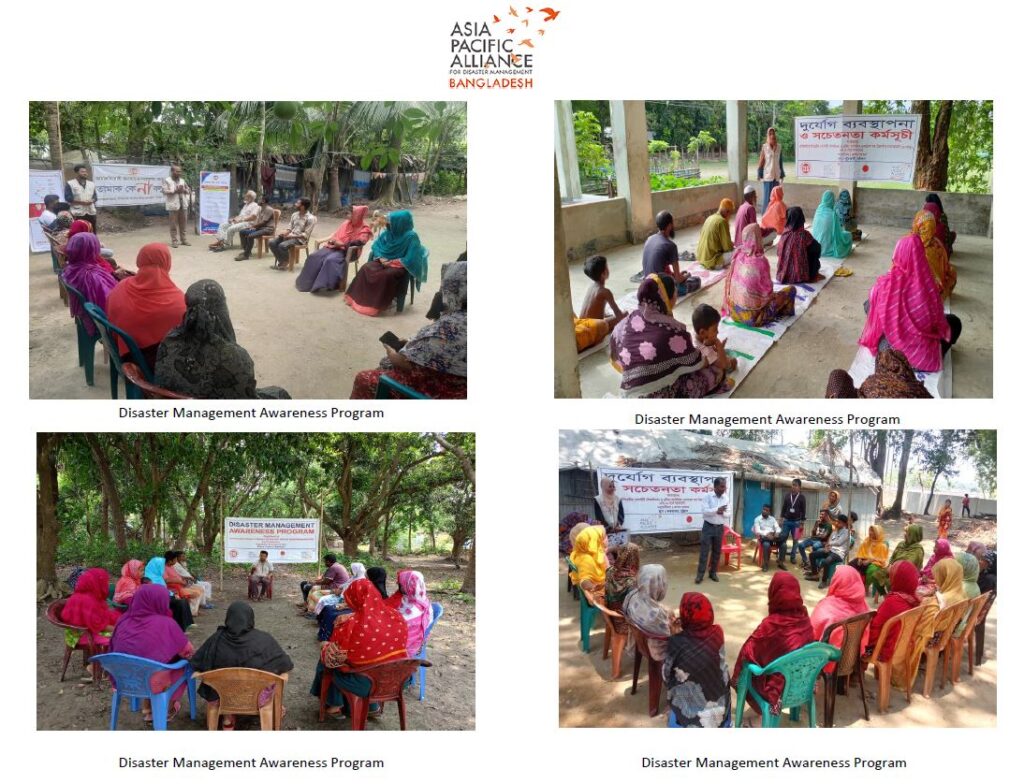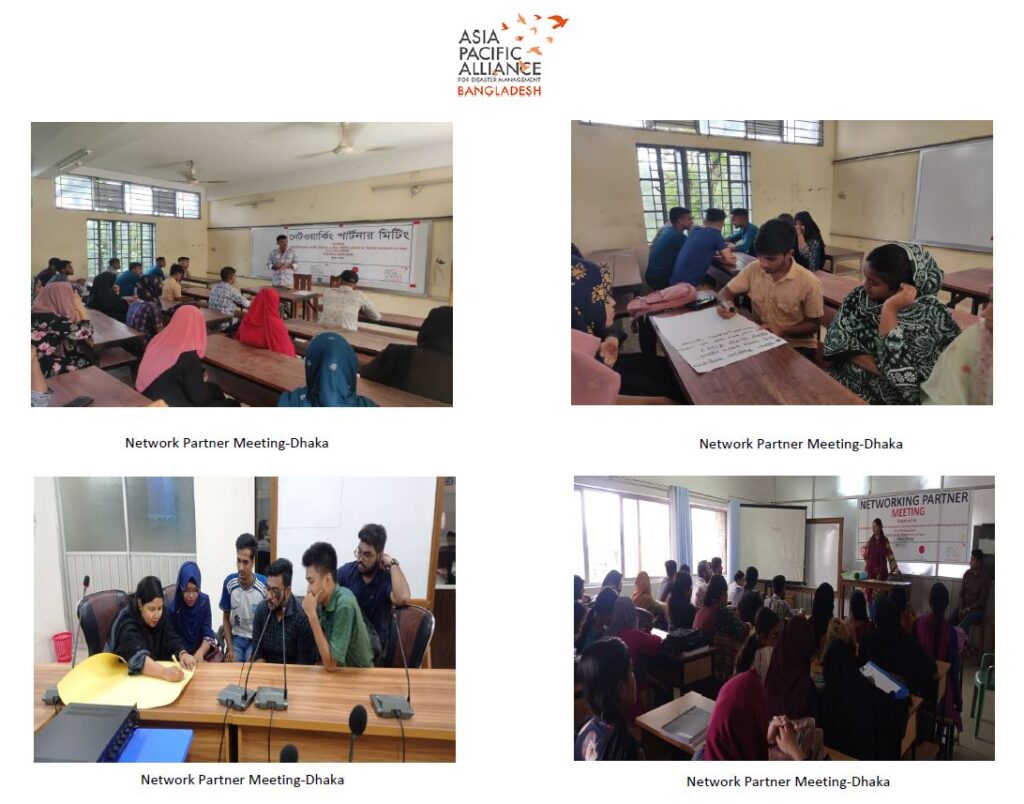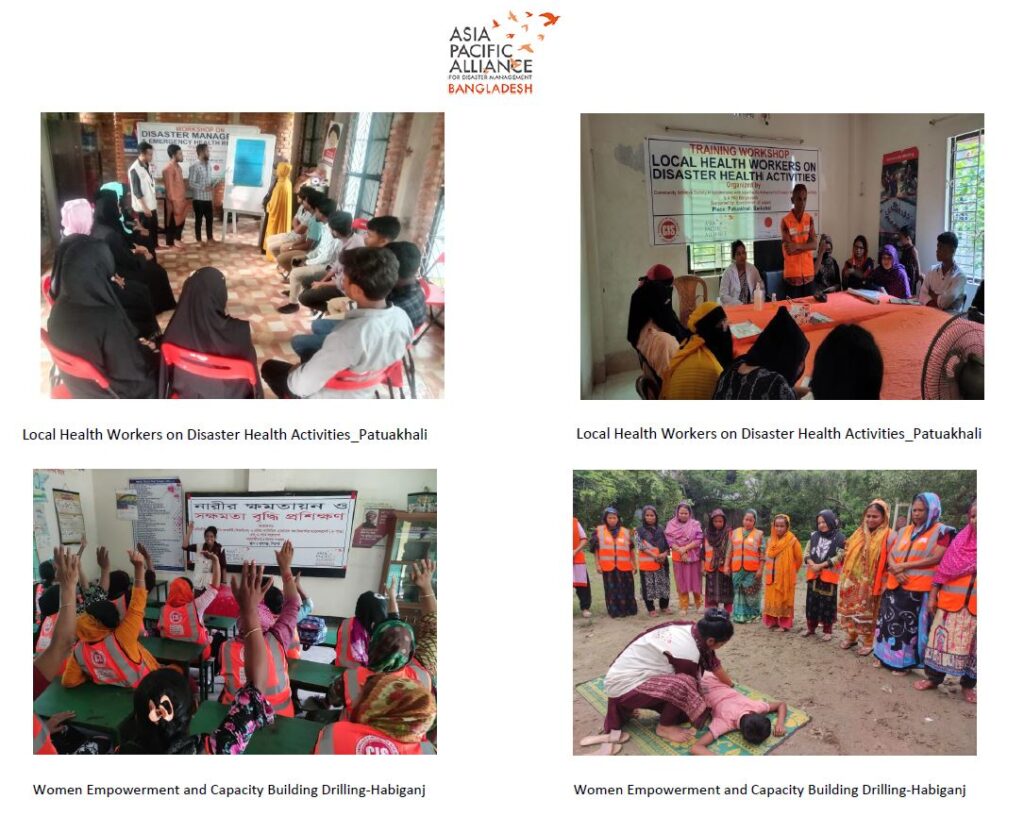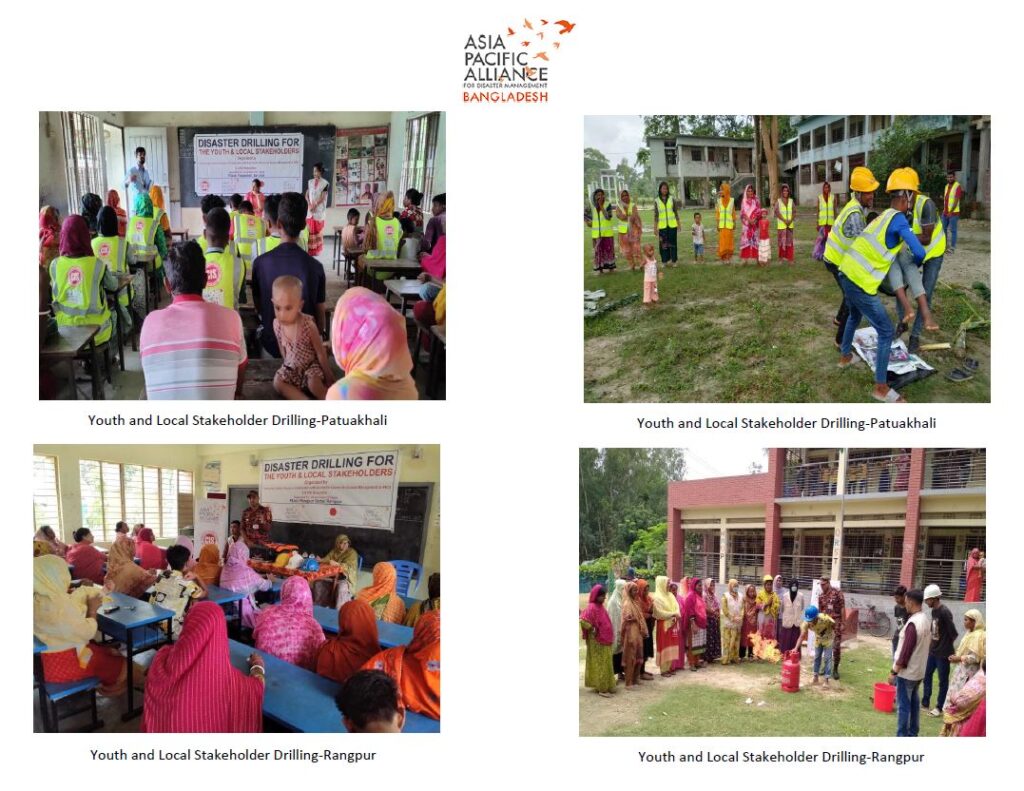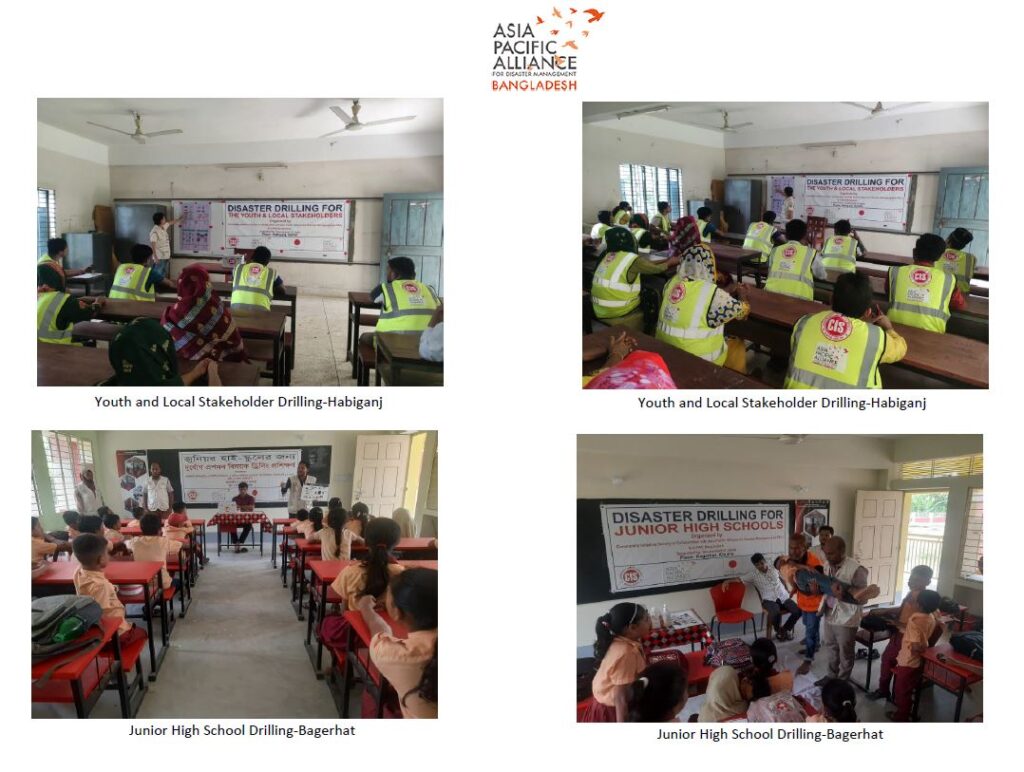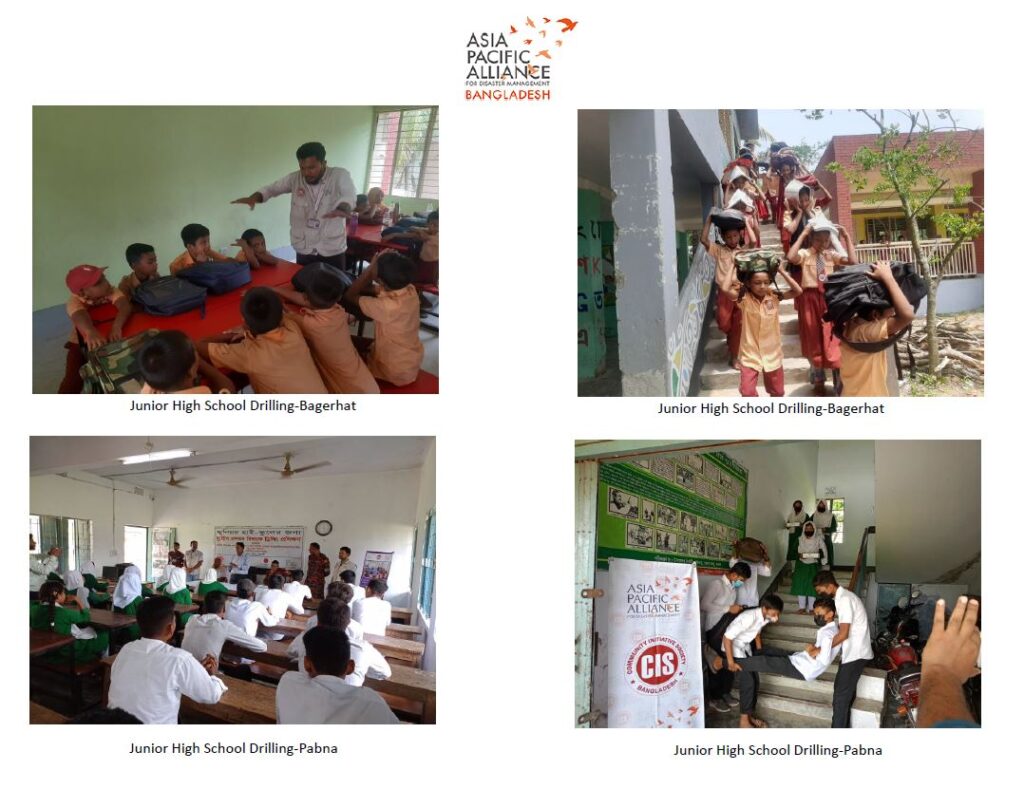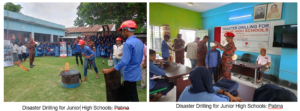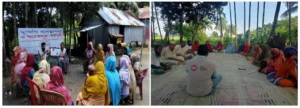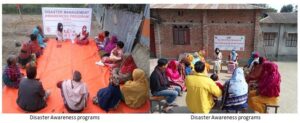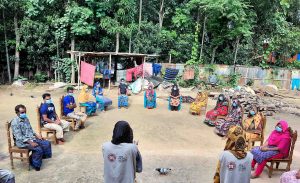Project Title: Strengthening Capacity for Sustainable Disaster Management Network by involving multi-sectoral platform Project Period: 17 January, 2024– 16 January, 2025 (12 month)
- Project Activities and Accomplishments
Bangladesh is ranking as one of the most disaster-prone countries. People in Bangladesh are often affected by water-related natural disasters, including floods, riverbank erosion and cyclones. In addition, recent rapid urbanization increases the risks for earthquake as well as man-made disasters. National Plan for Disaster Management (NPDM) 2021-2025 exemplified the strategic plan of the Government of Bangladesh in its Vision and the Mission of the Ministry of Disaster Management and Relief (MoDMR) between 2021 and 2025 towards building resilient nation. Bangladesh GOVT. has NPDM 2021-2025 has core goals for actions to save life, reduce economic losses in every disaster cycle stages which includes Disaster Risk Reduction (DRR), Humanitarian Response and Emergency Recovery Management. In Bangladesh most hazards impact: flood; cyclone and surge; tornado; earthquake; riverbank erosion; landslide; salinity intrusion; drought; tsunami; lightning; arsenic contamination; human-induced hazards and health hazards. The last hazard has potential for assuming significance because of the emerging risks in Bangladesh.
A-PAD Bangladesh started project from January 2023 and presently continue it 17 January 2024 to build up capacity on disaster management. It communicates with the different sectors like local community, community leaders, stakeholders, GOVT. officials continuing training on disaster management. To hold training program A-PAD Bangladesh staff organized small community meeting to sharing ideas on disaster and introduced them about A-PAD Bangladesh activity. A-PAD Bangladesh working 8 divisional areas.
There are 1 health workers in each divisions whose are doing home visit and aware the local community about basic disaster awareness. The health workers gave basic ideas about disaster management. A-PAD Bangladesh working at the rural areas. If there would be any directions or announcement from GOVT. or any disaster related news has been published the health workers delivered the message to the local community. Total 3,937 persons were benefited from A-PAD Bangladesh on June 2024.
A-PAD Bangladesh attended coordination meeting at the 8 divisions in Office of Deputy Commissioner. At that meeting different NGOs had joined and explained their activities. Besides this what will be the next activities of the GOVT. and NGOs were discussed at that meeting.
1. Strengthening of disaster risk reduction and disaster response system functions through the Emergency Disaster Management Coordination Center | ||
Activities | ( Outcome 1 ) The Emergency Disaster Management Coordination Center operated under this project will function as a disaster response base in each region, leading to the disaster risk reduction in the community and the strengthening of its disaster response system.: | Project Status: Achievements vs Outcome: If the activity is behind the schedule, please write the reason. |
1-1 Operation of Emergency Disaster Management Coordination Centers Target:Local communities 10 people×25 days×8 divisions×12 months =24,000 people | 【Indicators of Outcome】 1-1 The Emergency Disaster Management Coordination Center will be used for coordination meetings among partner organizations and relevant stakeholders during normal times, and will also serve as a center for health and public health guidance for the local residents. In the time of emergency, health services will be provided by emergency health workers. The Emergency Disaster Management Coordination Center will be used by 24,000 local residents (annual average) in the target area. (Indicator:number or visitors, record of services provided) 1-2 Through the Disaster Management Awareness Program, community residents will receive the latest disaster information and knowledge on how to respond to disasters, and people’s awareness of disaster prevention and response will be increased. (Indicator:Community disaster preparedness report) | Total 2,812 people visited to the Disaster Management Coordination Center to discuss about disaster preparedness and health related issues. Dhaka: 348 Persons Cox’s Bazar: 340 Persons Pabna: 342 Persons Bagerhat: 336 Persons Patuakhali: 339 Persons Habiganj: 367 Persons Rangpur: 380 Persons Netrokona: 360 Persons Total = 2,812 Persons |
1-2 Disaster Management Awareness Program Target:Local communities, Community leaders, Local NGOs, Private company workers, government officials 15 people × 8 divisions × 4 times ×12 months =5,760 people | A-PAD Bangladesh conducted Disaster Management Awareness programs at the 8 divisional areas where 441 persons have participated. Total 4 times training organized at each divisional areas. Dhaka:15 Participantsx 4 Sessons= 60+2=62 Participants Cox’s Bazar: 15 Participantsx 4 Sessons= 60+2=62 Participants Pabna: 15 Participantsx 4 Sessons= 60+3=63 Participants Bagerhat: 15 Participantsx 4 Sessons= 60+2=62 Participants Patuakhali: 15 Participantsx 4 Sessons= 60+3=63 Participants | |
|
| Habiganj: 15 Participantsx 4 Sessons= 60+4=64 Participants Rangpur: 15 Participantsx 4 Sessons= 60+5=65 Participants Netrokona: 15 Participants x 4 Sessons= 60+2=62 Participants |
2. Expansion of disaster management network to improve community vulnerability | ||
| (Outcome 2)The network of NPF will be expanded and the capacity of each region for disaster prevention and response will be strengthened. |
|
2-1 Network Partner Meeting Target : Local communities, Community leaders, Local NGO, Private Company Workers, Government officials 50 people × 5 villages × 8 divisions = 2,000 people | 【Indicator of Outcome】 2-1 Strategies, mechanisms, and action plans for disaster reduction cooperation are developed in each region through discussions at network partner meetings, and a framework for disaster reduction cooperation is established. (Indicator:Strategic Plan) 2-2 MOUs signed with at least 5 new organizations, including private companies, in A-PAD Bangladesh NPF to expand the network (Indicator:number of new MOUs signed) 2-4 Resources possessed by A-PAD BGD partner organizations are provided in emergency disaster response, and play the role of that organization in times of emergency. (Indicator:List of resources such as supplies, human resources and donations provided by partner | A-PAD Bangladesh organized 5 days Network partner Meeting at 5 villages in Dhaka. Total 264 participants has joined the meeting. 04 June 2024- Chowdhuripara: Total Participant- 50+4= 54 Participants 05 June 2024- Greenway: Total Participant- 50+2=52 Participants 06 June 2024- Gabtola: Total Participant- 50+2=52 Participants 08 June 2024- East Hajipara: Total Participant- 50+4=54 Participants 09 June 2024- Rajarbag: Total Participant- 50+2= 52 Participants Community Initiative Society (CIS) organized a Networking Partners Meeting in response to the pressing need for efficient disaster management in Dhaka, a city prone to various natural calamities. The purpose of the meeting was to convene key stakeholders from different sectors to develop a unified and effective strategy for handling disasters. The event marked a significant milestone in the journey towards creating a more resilient and disaster-ready community in Dhaka. By fostering collaboration, sharing |
| organizations for emergency disaster response) | valuable insights, and engaging in strategic planning, the |
| meeting set the stage for a more coordinated and effective | |
| approach to disaster management. The partnerships forged, | |
| knowledge exchanged, and resource mobilization plans | |
| devised during the meeting are poised to play a vital role in | |
| contributing to a future that is more resilient and sustainable. | |
| The 5-day program brought together individuals from diverse | |
| locations, allowing them to share their firsthand experiences | |
| and perspectives on disasters and disaster management. | |
2-2 Disaster Preparedness |
|
|
Campaigns Target:Partner |
| |
organizations and local |
| |
communities |
| |
50 people × 2 times × 8 |
| |
divisions = 800 people |
| |
2-3 Network Partners Capacity Strengthening (DRR) Target : Partner organizations 20 people × 2 organizations × 2 times × 8 divisions = 640 people |
| A-PAD Bangladesh Organized Network Partner Capacity |
| Strengthening DRR at Pabna and Mymensingh. | |
| 08-09 June 2024, Mymensingh, Total Participants 40+3=43 | |
| Participants | |
| 26-27 June 2024, Pabna, Total Participants 40+2= 42 | |
| Participants. | |
| Pabna district in Bangladesh is prone to disasters such as | |
| floods, cyclones, thunderstorms, heavy rainfall, and fire. | |
| A training workshop was conducted by CIS in Pabna on 26 and | |
| 27 June 2024, focusing on emergency response capacity | |
| building during and after disasters. The training program, | |
| called Network Partner Capacity Strengthening DRR, was |
|
| attended by the local community, community leaders, local NGOs, and non-governmental organizations. The two-day training covered various topics, with the primary focus on network partner capacity strengthening for Disaster risk reduction. It have been established with the objective of leveraging this experience to promote interdisciplinary approaches to disaster research. The implementation of housing and community facilities that adhere to construction standards for both earthquake and cyclone resistance, as well as their approval by communities and relevant government technical departments, exemplify practical measures that contribute to mitigating future risks for residents in a naturally hazardous region. Moreover, operating during the transitional phase between response and rehabilitation has enabled stakeholders to create improved opportunities for community mobilization, vocational training, establishment of temporary community infrastructure, and reinstatement of vital community activities such as schools and markets. |
2-4 Seminar for Developing New Disaster Prevention Solutions Target : NGO, Disaster prevention related government organizations, Private sector personnels 30 people ( 2days ) × 8 divisions × 2 times = 480 |
2 days seminar has been organized in Rangpur. Total 32 participants had joined the seminar.
23-24 June 2024, Rangpur, Total participants 30+2=32 Participants During the interactive discussions, presentations, and workshops, participants delved into various topics concerning disaster risk reduction, early warning systems, |
people |
| infrastructure resilience, community-based preparedness, and sustainable development strategies. The seminar fostered innovative thinking and urged participants to think creatively in order to devise effective and sustainable solutions. In summary, the seminar focusing on the development of new disaster prevention solutions in Rangpur offered a valuable platform for stakeholders to convene, exchange knowledge and experiences, and collectively contribute to the establishment of a more resilient and disaster-resilient community. It is anticipated that the concepts generated during the seminar will guide future endeavors and play a pivotal role in ensuring the long- term safety and well-being of the people of Rangpur. |
2-5 International Symposium on DRR Target : Government, Local government, private company, NOG, partner organization, representative of A-PAD member countries, etc. 200 people |
| |
3. Practical training to improve resilience of local communities | ||
| ( Outcome 3 ) Contribute to improving the disaster resilience of local communities through practical training. |
|
3-1 Disaster response capacity building of local | 【Indicator of Outcome】 |
|
community level in Health and hygiene field | 3-1 a) Establish networks of community leaders who can lead disaster response and emergency health response in all districts of |
|
3-1 a) Workshop on Disaster Management and Emergency Health Response Target : Local residents, Community leaders, Local NGO workers 25 people ( 2 days ) × 8 divisions × 2 times = 400 people | Bangladesh. (Indicator:Number and the List of community leaders for disaster response/emergency health in each 8 districts.) b) Networks of human resources with the skills and know-how to respond to health emergencies will be established in all districts of Bangladesh to provide health services to the local residents in times of emergency. (Indicator:Data of NGO health personals who can respond in emergency. Number of residents who received the services in the cases of activities during emergency disaster in each 8 districts.)
3-2 a) Disaster preparedness training and drills will be documented in a manual, and women, youth groups, and local stakeholders who participate in the drills will be granted certificates of completion and work as disaster volunteer teams during actual disasters. (Indicator:Drilling Manual, Cases of activities in | A-PAD Bangladesh conducted 2 days workshop at Cox’s Bazar, total 56 participants joined the training workshop. 25-26 June 2024, Cox’s Bazar, Total 25+3=28 participants
The Cox’s Bazar chapter of the Civil Information and Services (CIS) recently organized an extensive two-day workshop focused on disaster management and emergency health in Cox’s Bazar Sadar. The primary objective of the workshop was to enhance awareness and understanding of disaster risk reduction and emergency health measures. The training agenda encompassed crucial topics including First Aid, CPR, rescue operations, and recent occurrences such as heatwaves, storms, Dengue, Conjunctivitis, and more. Additionally, the workshop aimed to bolster the emergency health response capabilities of local government health workers, NGOs, private organizations, and other stakeholders to effectively address prevalent health issues during and after climate-related disasters. In essence, the workshop represented a significant stride toward building capacity for emergency health response in Cox’s Bazar Sadar. |
3-1 b) Training of Local Health Workers on Disaster Health | A-PAD Bangladesh organized local health workers training at Patuakhali. Total 22 participants joined the training. |
Activities Target : Health workers who belong to local NGOs or civil organizations 20 people ( 3 days ) × 8 divisions = 160 people | emergency disaster response)
b) Disaster drills at junior high schools will be documented in a manual so that students who participate in the drills will have the skills to take appropriate action in the event of a disaster. (Indicator:Drilling Manual, Report of emergency disaster response) | 03-05 June 2024, Patuakhali, Total Participants 20+2=22 Participants The training program was thoughtfully crafted to encompass a broad spectrum of subjects including disaster risk reduction, emergency response, and public health interventions during disasters. The program consisted of multiple modules, each dedicated to a specific facet of disaster health activities. Throughout the program, participants received instruction in conducting rapid health assessments, identifying and addressing common health issues during disasters, and providing psychosocial support. The theoretical portions of the training focused on establishing a robust knowledge base, while the practical segments provided hands-on experience in applying acquired knowledge and skills in simulated disaster scenarios. The program underscored the importance of coordination and collaboration among various stakeholders. Participants were trained to work in concert with local government officials, non-governmental organizations, and community members to ensure effective disaster management. Furthermore, the program emphasized the development of strong communication abilities and leadership qualities among the participants. Overall, the training program was highly successful. |
3-2 Strengthening disaster response capacities of local communities through disaster drilling training |
| |
3-2 a) | Two days drilling program organized in Habiganj where 25 |
Women Empowerment and Capacity Building Target : Women’s groups in target villages 20 people ( 2 days ) × 8 divisions × 2 times = 320 people |
| women has been joined the drilling program.
12-13 June 2024, Habiganj, Total 20+5=25 Participants
A-PAD Bangladesh recently conducted an extensive training program in Habiganj focused on women’s empowerment and capacity-building. The program, led by the competent Fire Service and Civil Defense team, spanned two days. The first day emphasized educating the participants on fire, flood, and earthquake prevention, with instructors providing demonstrations of appropriate responses to such disasters using manuals. The second day involved practical hands-on training for the participants on preventive measures and response techniques. This training was particularly significant given Bangladesh’s susceptibility to severe flooding, with drowning being the leading cause of death in children, claiming nearly 50 lives per day. Various factors, including insufficient parental supervision, maternal illiteracy, lack of swimming ability, gender, age, geographical and environmental conditions, seasonality, and disasters, contribute to child drowning deaths in Bangladesh. It’s noteworthy that CIS conducted a session to equip mothers and women with the skills to prevent child drowning, which is commendable and addresses a critical need. |
3-2 b) Disaster Drilling for the Youth and Local Stakeholders Target:Youth in the local | Youth and local stakeholder drilling program organized in Patuakhali and Rangpur where 96 participants joined. 10-11 June 2024, Rangpur, Total 45+3=48 Participants 12-13 June 2024, Patuakhali, Total 45+5=50 Participants |
private and civic sector 45 people ( 2 days ) × 8 divisions × 2 times = 720 people |
| 29-30 June 2024, Habiganj, Total Participants 45+2=47 Participants
The CIS team demonstrated comprehensive preparedness and dedication in enhancing the participants’ emergency response capabilities. The program encompassed a diverse array of topics, including the effects of climate change on various disasters, lightning protection measures, first aid administration, and fundamental hygiene and sanitation practices. Moreover, the participants received training on identifying early signs of impending disasters and implementing appropriate measures to mitigate potential damage. For instance, in the event of a gas cylinder leak, it is advisable to ventilate the area by opening doors and windows and, if ignited, to smother the fire with dampened sacks or blankets. Likewise, in the case of a fire resulting from a short circuit, the primary electrical switch should be turned off if feasible. Additionally, apart from fire safety, the program encompassed other commonplace disasters in the area, such as cyclones, tidal floods, unpredictable rainfall, cold waves, arsenic contamination, and tornadoes. Participants were equipped with the knowledge to prepare for and respond effectively to these disasters. A participant, employed in a non-governmental organization, expressed appreciation to the CIS team for orchestrating a highly beneficial training program. He acquired valuable knowledge to apply in future scenarios and to disseminate to his associates, neighbors, and community members regarding essential disaster response protocols for fires, lightning, and cyclones. Ultimately, the training program |
|
| stands as a commendable initiative certain to yield substantial benefits for the local community by mitigating the impact of natural disasters. |
3-2 c) Disaster Drilling for Junior High Schools Target:School Children 40 people ( 2 days ) × 8 divisions × 2 times = 640 people | Disaster Drilling for Junior High School conducted in 2 Divisional areas Bagerhat and Pabna. Total 80 participants joined the drilling program. 09-10 June 2024, Pabna, Total 40 Participants 10-11 June 2024, Bagerhat, Total 40+3 Participants | |
| During the program, the students were divided into two | |
| groups. One group acted as victims, while the other group | |
| constituted the rescue team. Feedback from the students | |
| reflected their appreciation towards the resource persons | |
| and organizers for orchestrating such a beneficial program. | |
| One of the pivotal topics covered was the immediate actions | |
| to be taken in the event of an earthquake. The students were | |
| trained on proper procedures to descend the stairs and | |
| protect themselves during a seismic event. Additionally, they | |
| received instruction on administering first aid and rescuing | |
| vulnerable individuals in the event of a fire or earthquake. | |
| The recent emergence of a concerning phenomenon known | |
| as the “Heat wave” prompted discussions on safety measures | |
| and strategies to mitigate its effects in the future. | |
| Subsequently, the students were evacuated to pre-assigned | |
| assembly points according to a color-coded evacuation plan. |
|
|
The Disaster Drilling Program for Junior High School was |
coordinated by the CIS in partnership with the Fire Service & | ||
Civil Defense-Habiganj. The program encompassed simulated | ||
evacuation drills, first aid demonstrations, and hands-on | ||
instruction in the operation of emergency equipment such as | ||
fire extinguishers. These activities provided students with | ||
valuable insights and skills for addressing various emergency | ||
scenarios. The program’s objectives included raising | ||
awareness, promoting preparedness, honing response | ||
capabilities, fostering collaboration, instilling confidence, | ||
nurturing leadership, enhancing community resilience, | ||
facilitating communication, fostering critical thinking, and | ||
cultivating a culture of safety. By achieving these goals, the | ||
program sought to cultivate a generation of informed, | ||
prepared, and competent young individuals capable of | ||
making positive contributions to community safety and well- | ||
being during crises. Notable participants in the program | ||
included junior high school students, educators and staff, and | ||
the Fire Service & Civil Defense. | ||
3-3 Update website |
| |
contents as E-resources | ||
for Disaster | ||
Management | ||
| ||
| ||
| ||
| ||
|
|
| https://apad-bd.org/wp-content/uploads/2024/07/3- 2.webp https://apad-bd.org/wp-content/uploads/2024/07/4- 2.webp https://apad-bd.org/wp-content/uploads/2024/07/5- 2.webp |
- Challenges
Please write Challenges and its impact upon the project implementation. (Ex. lockdown, Political situation, Curfew)
- Practice in collaboration with A-PAD Bangladesh Network Partners Please write good practice in collaboration with partner organizations
- Any contribution Funds Received and Grants Applied / Planned and Implemented Projects by CIS including Emergency Response
Please write Projects name and its fund resources
- Relationship with Bangladesh Government and Japanese Embassy
Please write about Meeting with Government officials
